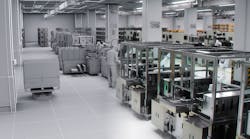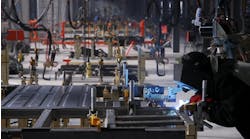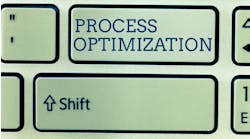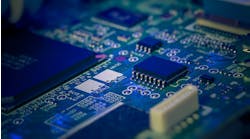NVIDIA generative AI and Omniverse digitalizing factories
NVIDIA announced that electronics manufacturers worldwide are advancing their industrial digitalization efforts using a new, comprehensive reference workflow that combines NVIDIA technologies for generative AI, 3D collaboration, simulation and autonomous machines. Supported by an expansive partner network, the workflow helps manufacturers plan, build, operate and optimize their factories with an array of NVIDIA technologies, they note, including NVIDIA Omniverse, which connects top computer-aided design apps as well as APIs and cutting-edge frameworks for generative AI; the NVIDIA Isaac Sim application for simulating and testing robots; and the NVIDIA Metropolis vision AI framework, now enabled for automated optical inspection.
In his keynote address at COMPUTEX, NVIDIA founder and CEO Jensen Huang showcased a demo of an entirely digitalized smart factory—an industry first for electronics makers, claims NVIDIA. “The world’s largest industries make physical things. Building them digitally first can save enormous costs,” said Huang. “NVIDIA makes it easy for electronics makers to build and operate virtual factories, digitalize their manufacturing and inspection workflows, and greatly improve quality and safety while reducing costly last-minute surprises and delays.”
The new reference workflow is being used by Foxconn Industrial Internet, Innodisk, Pegatron, Quanta and Wistron as they work to optimize their workcell and assembly line operations while lowering production costs. Foxconn Industrial Internet, a service arm of the world’s largest technology manufacturer, is working with NVIDIA Metropolis ecosystem partners to automate significant portions of its circuit-board quality-assurance inspection points.
“NVIDIA’s strength in AI and its strong ecosystem of application partners are providing Foxconn Industrial Internet with a path to significant operational efficiency gains,” said Tai-Yu Chou, CTO at Foxconn Industrial Internet. “The combination of NVIDIA Metropolis for factories and Isaac Sim for robotics is helping us realize industrial automation goals faster than ever imagined.”
Innodisk is deploying NVIDIA Metropolis to automate optical-inspection processes on its production lines, saving cost and improving production efficiency. Pegatron is using the reference workflow to digitalize its circuit-board factories with simulation, robotics and automated production inspection.
“NVIDIA Omniverse, Isaac Sim and Metropolis give us the ability to accomplish AI training, enhance factory workflows and run numerous simulations in the virtual world before we commit to an idea in the physical world,” said Andrew Hsiao, associate vice president of the software R&D division at Pegatron. “Digitalizing our entire factory enables us to simulate the robotics and automation pipeline from end to end, and lets us try things out in a simulated environment, which saves time and greatly reduces costs.”
Quanta, a major manufacturer of laptops and other electronic hardware, is using AI robots from its subsidiary Techman Robot to inspect the quality of manufactured products. Techman is leveraging Isaac Sim to simulate, test and optimize its state-of-the-art collaborative robots while using NVIDIA AI and GPUs for inference on the robots themselves.
Wistron, one of the world’s largest suppliers of information and communications products, is tapping NVIDIA Omniverse to build digital twins of its automated receiving lines and operations buildings using inputs from Autodesk AutoCAD, Autodesk Revit and FlexSim. Wistron also uses NVIDIA Metropolis to automate portions of its circuit-board optical inspection using AI-enabled computer vision.



